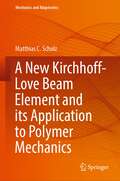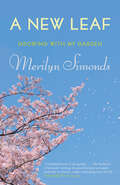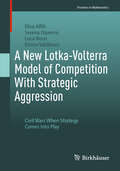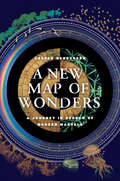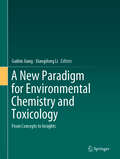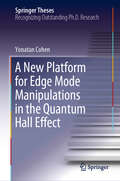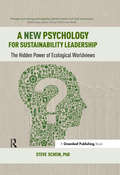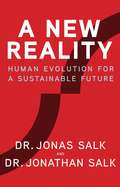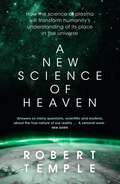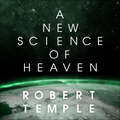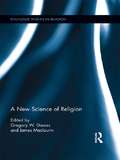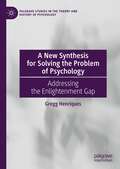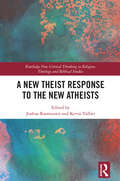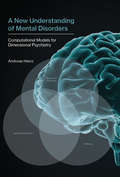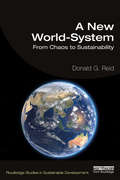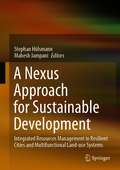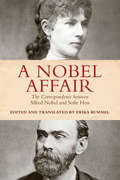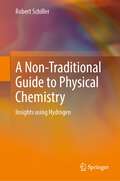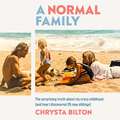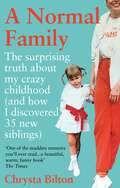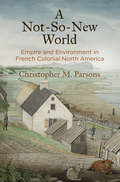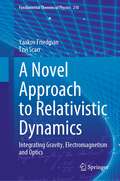- Table View
- List View
A New Kirchhoff-Love Beam Element and its Application to Polymer Mechanics (Mechanics and Adaptronics)
by Matthias C. SchulzThe novel finite element formulations fall into the category of geometrically exact Kirchhoff-Love beams. A prominent characteristic of this category is that the absence of shear deformation is strongly enforced by removing two degrees of freedom. Further, the corresponding beam theories exhibit not only translational but also rotational degrees of freedom and their configurations thus form a non-additive and non-commutative space. Sophisticated interpolation schemes are required that need to be tested not only for locking, spatial convergence behavior, and energy conservation, but also for observer invariance and path-independence. For the three novel beam element formulations all these properties are analytically and numerically studied and confirmed, if applicable. Two different rotation parameterization strategies are employed based on the well-known geodesic interpolation used in many Simo-Reissner beams and the lesser known split into the so-called \textit{smallest rotation} and a torsional part. Application of the former parameterization results in a mixed finite element formulation intrinsically free of locking phenomena. Additionally, the first geometrically exact Kirchhoff-Love beam element is presented, which strongly enforces inextensibility by removing another degree of freedom. Furthermore, the numerical efficiency of the new beam formulations is compared to other beam elements that allow for or suppress shear deformation. When modeling very slender beams, the new elements offer distinct numerical advantages.Standard molecular dynamics simulations, which are commonly used to study polymers, suffer from a lack of a careful mathematical basis and the use of an expensive explicit time integration scheme. To circumvent these shortcomings and to be able to simulate stretching experiments on relevant time scales, the problem is described by a stochastic partial differential equation, which can be solved using the finite element method with a backward Euler temporal discretization. In detail, the polymer is represented by a Kirchhoff-Love beam with a linear elastic constitutive model. Inertial and electrostatic forces are neglected. It is deformed by a distributed load mimicking collisions with molecules of the surrounding fluid. Naturally, this load heavily fluctuates over time and space and mean values need to be computed in a Monte Carlo manner. To vastly speed up the fitting process to experimental data in a Bayesian framework, a surrogate model based on a Gaussian process is set up, which directly computes the mean values for given material parameters. The uncertainties and correlations of the material parameters are studied and compared to the literature.
A New Leaf: Growing with My Garden
by Merilyn SimondsA graceful and sharply observed book of inspiration that uses the garden as its central museA New Leaf traces a year of growing seasons at The Leaf, Merilyn Simonds' acreage in eastern Ontario. A lifelong gardener, Simonds works the soil and the soul for wide-ranging revelations about everything from flowers that keep time, to the strange gift of compost, to great gardens of the world, to things lost and found underground.She is joined on her journey by a host of companions—including her Beloved, who tills by her side; the Rosarian, who tends to both bud and thorn in roses and life; and the Frisarian, who weeds unwelcome visitors to make room for new growth. Intelligent and intimate, irreverent and elegant, A New Leaf offers a cornucopia of enrichment and inspiration for the fertile mind.
A New Lotka-Volterra Model of Competition With Strategic Aggression: Civil Wars When Strategy Comes Into Play (Frontiers in Mathematics)
by Luca Rossi Enrico Valdinoci Serena Dipierro Elisa AffiliThis monograph introduces a new mathematical model in population dynamics that describes two species sharing the same environmental resources in a situation of open hostility. Its main feature is the expansion of the family of Lotka-Volterra systems by introducing a new term that defines aggression. Because the model is flexible, it can be applied to various scenarios in the context of human populations, such as strategy games, competition in the marketplace, and civil wars. Drawing from a variety of methodologies within dynamical systems, ODEs, and mathematical biology, the authors' approach focuses on the dynamical properties of the system. This is accomplished by detecting and describing all possible equilibria, and analyzing the strategies that may lead to the victory of the aggressive population. Techniques typical of two-dimensional dynamical systems are used, such as asymptotic behaviors regulated by the Poincaré–Bendixson Theorem. A New Lotka-Volterra Model of Competition With Strategic Aggression will appeal to researchers and students studying population dynamics and dynamical systems, particularly those interested in the cross section between mathematics and ecology.
A New Map of Wonders: A Journey in Search of Modern Marvels
by Caspar Henderson“Henderson teaches us how to wonder anew with a new vision of science illuminated by a rich range of literature, philosophy, art, and music.” —Hugh Aldersey-Williams, author of Dutch LightWe live in a world that is known, every corner thoroughly explored. But has this knowledge cost us the ability to wonder? Wonder, Caspar Henderson argues, is at its most supremely valuable in just such a world because it reaffirms our humanity and gives us hope for the future. That’s the power of wonder, and that’s what we should aim to cultivate in our lives. But what are the wonders of the modern world?Henderson’s brilliant exploration borrows from the form of one of the oldest and most widely known sources of wonder: maps. Large, detailed mappae mundi invited people in medieval Europe to vividly imagine places and possibilities they had never seen before: manticores with the head of a man, the body of a lion, and the stinging tail of a scorpion; tribes of one-eyed men who fought griffins for diamonds; and fearsome Scythian warriors who drank the blood of their enemies from their skulls. A New Map of Wonders explores these and other realms of the wonderful, in different times and cultures and in the present day, taking readers from Aboriginal Australian landscapes to sacred sites in Great Britain, all the while keeping sight questions such as the cognitive basis of wonder and the relationship between wonder and science.Beautifully illustrated and written with wit and moral complexity, this sequel to The Book of Barely Imagined Beings is a fascinating account of the power of wonder and an unforgettable meditation on its importance to our future.
A New Meta-heuristic Optimization Algorithm Based on the String Theory Paradigm from Physics (SpringerBriefs in Applied Sciences and Technology)
by Luis Rodriguez Oscar CastilloThis book focuses on the fields of nature-inspired algorithms, optimization problems and fuzzy logic. In this book, a new metaheuristic based on String Theory from Physics is proposed. It is important to mention that we have proposed the new algorithm to generate new potential solutions in optimization problems in order to find new ways that could improve the results in solving these problems. We are presenting the results for the proposed method in different cases of study. The first case, is optimization of traditional benchmark mathematical functions. The second case, is the optimization of benchmark functions of the CEC 2015 Competition and we are also presenting results of the CEC 2017 Competition on Constrained Real-Parameter Optimization that are problems that contain the presence of constraints that alter the shape of the search space making them more difficult to solve. Finally, in the third case, we are presenting the optimization of a fuzzy inference system, specifically for finding the optimal design of a fuzzy controller for an autonomous mobile robot. It is important to mention that in all study cases we are presenting statistical tests in or-der to validate the performance of proposed method. In summary, we believe that this book will be of great interest to a wide audience, ranging from engineering and science graduate students, to researchers and professors in computational intelligence, metaheuristics, optimization, robotics and control.
A New Paradigm for Environmental Chemistry and Toxicology: From Concepts to Insights
by Guibin Jiang Xiangdong LiThis book provides comprehensive coverage of the theoretical developments and technological breakthroughs that have deepened our understanding of environmental pollution and human health, while also promoting a comprehensive strategy to address these problems. The respective chapters highlight groundbreaking concepts fueling the development of environmental chemistry and toxicology; revolutionary analytical and computational approaches providing novel insights into environmental health; and nature-inspired, innovative engineering solutions for tackling complex hazardous exposures. The book also features a forward-looking perspective on emerging environmental issues that call for new research and regulatory paradigms, laying the groundwork for future advances in the broad field of environmental chemistry and toxicology. Written by respected authorities in the field, A New Paradigm for Environmental Chemistry and Toxicology - From Concepts to Insights will offer an invaluable reference guide for concerned researchers and professional practitioners for years to come.
A New Platform for Edge Mode Manipulations in the Quantum Hall Effect (Springer Theses)
by Yonatan CohenIn the last several decades, the quantum Hall effect has provided a remarkable platform for manipulating one-dimensional electronic modes and investigating fundamental physical phenomena. However, certain limitations make it difficult for various kinds of interesting modes structures to be formed using this platform. One example is the so called helical mode structure, in which two one-dimensional, counter propagating modes have opposite spins and thus spin and momentum are locked. Such helical modes have lately attracted significant interest, since, when coupled to a conventional superconductor, they are expected to manifest topological superconductivity and host Majorana zero modes. Even more interesting are fractional helical modes, which open the way for realizing generalized parafermionic zero modes. Possessing non-abelian exchange statistics, these quasiparticles may serve as building blocks in topological quantum computing. Here we present a new platform for manipulating integer and fractional quantum Hall edge modes, which allows the formation of robust one-dimensional helical as well as fractional helical modes. The platform is based on a carefully designed double-quantum-well structure in a GaAs based system hosting two electronic sub-bands in the quantum Hall effect regime. By electrostatic gating of different areas of the structure, counter-propagating integer, as well as fractional, edge modes with opposite spins are formed and their spin protection is verified. Beyond the formation of helical modes, the new platform can serve as a rich playground for new research. Some new possibilities include the artificial induction of compounded fractional edge modes and the construction of new edge mode-based interferometers.
A New Psychology for Sustainability Leadership: The Hidden Power of Ecological Worldviews
by Steve ScheinDuring the last decade, the sustainability position in multinational corporations has grown in influence. Much literature has explored how corporations can play an important role in solving the environmental challenges facing the planet. However, until now, there has been little research on sustainability leadership at the individual level. In this book, Schein explores the deeper psychological motivations of sustainability leaders. He shows how these motivations relate to overall effectiveness and capacity to lead transformational change and he explores the ways in which the complexity of sustainability is driving new approaches to leadership.Drawing on interviews with 75 leaders from over 40 multinational corporations and NGOs, Schein explores how ecological worldviews are developed and expressed in global sustainability practice. By applying key theories from developmental psychology, integral ecology and eco-psychology to sustainability practice, Schein encourages us to think about leadership in a different way. A New Psychology for Sustainability Leadership will be of interest to an interdisciplinary audience of social scientists, educators, corporate executives, and social entrepreneurs. The insights from this book can be usefully integrated into leadership curriculum and development programs to help the next generation of leaders respond to global challenges.
A New Reality: Human Evolution for a Sustainable Future
by Jonas Salk Jonathan Salk David Dewane Elizabeth H BlackburnA New Reality: Human Evolution for a Sustainable Future provides a startling, fresh new message of understanding, perspective and hope for today’s tense, rapid-fire, kaleidoscopically changing world. A New Reality: Human Evolution for a Sustainable Future provides a startling, fresh new message of understanding, perspective and hope for today’s tense, rapid-fire, kaleidoscopically changing world. Drawn from the writings of visionary scientist Jonas Salk, who developed the polio vaccine, extended and developed by his son Jonathan, the message of the book explodes from the past and sheds light on tensions that besiege us and the currents of discord that are raging as these words are written. More importantly, it indicates a way forward out of our current situation. Written by a world-famous doctor and folk hero, based on population data, rich in visual imagery, elegantly designed, and clearly written, A New Reality is unique in the marketplace. Readable in one or two sittings, it is accessible to the general reader while at the same time being of essential value to policy makers and academics. Its brevity and simplicity of design belie the importance and sophistication of its message. “We are at a point in the course of human social evolution when the demands of survival converge with the higher ideals of humankind and the well-being and flourishing of human society. It is up to us to see that we navigate this transition, adapting to and emerging in a new reality.” —A New Reality Our country is divided and polarized. Terrorism is a major threat throughout much of the world. Mass migrations are causing national and international tension. Population growth continues to increase, especially in the developing regions of the world. Controversy rages as to the use of fossil fuels versus the development of alternative forms of energy. Disagreement continues about climate change. Opposing currents of opinion collide as to how much we should help other areas in the world and how much to help ourselves. Basic values are in conflict. More than 40 years ago, Jonas Salk understood that we are at a unique moment in the history of the human species. After centuries of increase, population growth has begun to slow and is trending toward equilibrium. This change is accompanied by an equally significant change in human values—a shift from those based on unlimited availability of resources, unremitting growth, excess, independence, competition and short-term thinking to those based on limits, equilibrium, balance, interdependence, cooperation and long-term thinking. This momentous transition is the source of far-reaching tension and conflict. The way through this difficult era is to understand its basis and to focus on new values that will be of the greatest benefit to humankind. There is an urgency, however, and failure to adapt will result in disaster both for humanity and for the planet as a whole. A New Reality delivers a message of both caution and hope. Readers across the social and political spectrum will find it a reasoned and balanced counterpoint to current social and political trends. Its elegant design and long-range perspective will appeal to general readers, policy makers, millennials, baby boomers, teachers, and students, filling a need in the marketplace for a work of positivity and wisdom in otherwise bleak times.
A New Science of Heaven: How the new science of plasma physics is shedding light on spiritual experience
by Robert Temple'This book is an important contribution, and I hope it will open many minds. What is particularly important in it are the discussions of David Bohm, of bioplasma, biophotons, and bioelectronics.' - PROFESSOR ZBIGNIEW WOLKOWSKI, Sorbonne University, ParisThe story of the science of plasma and its revolutionary implications for the way we understand the universe and our place in it.Histories of science in the 20th century have focused on relativity and quantum mechanics. But, quietly in the background, there has been a third area of exploration which has equally important implications for our understanding of the universe. It is unknown to the general public despite the fact that many Nobel prize winners, senior academics and major research centres around the world have been devoted to it - it is the study of plasmaPlasma is the fourth state of matter and the other three - gas, liquid and solids - emerge out of plasma. This book will reveal how over 99% of the universe is made of plasma and how there are two gigantic clouds of plasma, called the Kordylewski Clouds, hovering between the Earth and the Moon, only recently discovered by astronomers in Hungary. Other revelations not previously known outside narrow academic disciplines include the evidence that in certain circumstances plasma exhibits features that suggest they may be in some sense alive: clouds of plasma have evolved double helixes, banks of cells and crystals, filaments and junctions which could control the flow of electric currents, thus generating an intelligence similar to machine intelligence. We may, in fact, have been looking for signs of extra-terrestrial life in the wrong place.Bestselling author Robert Temple has been following the study of plasma for decades and was personally acquainted with several of the senior scientists - including Nobel laureates - at its forefront, including Paul Dirac, David Bohm, Peter Mitchell and Chandra Wickramasinghe (who has co-written an academic paper with Temple).
A New Science of Heaven: How the new science of plasma physics is shedding light on spiritual experience
by Robert Temple'This book is an important contribution, and I hope it will open many minds. What is particularly important in it are the discussions of David Bohm, of bioplasma, biophotons, and bioelectronics.' - PROFESSOR ZBIGNIEW WOLKOWSKI, Sorbonne University, ParisThe story of the science of plasma and its revolutionary implications for the way we understand the universe and our place in it.Histories of science in the 20th century have focused on relativity and quantum mechanics. But, quietly in the background, there has been a third area of exploration which has equally important implications for our understanding of the universe. It is unknown to the general public despite the fact that many Nobel prize winners, senior academics and major research centres around the world have been devoted to it - it is the study of plasmaPlasma is the fourth state of matter and the other three - gas, liquid and solids - emerge out of plasma. This book will reveal how over 99% of the universe is made of plasma and how there are two gigantic clouds of plasma, called the Kordylewski Clouds, hovering between the Earth and the Moon, only recently discovered by astronomers in Hungary. Other revelations not previously known outside narrow academic disciplines include the evidence that in certain circumstances plasma exhibits features that suggest they may be in some sense alive: clouds of plasma have evolved double helixes, banks of cells and crystals, filaments and junctions which could control the flow of electric currents, thus generating an intelligence similar to machine intelligence. We may, in fact, have been looking for signs of extra-terrestrial life in the wrong place.Bestselling author Robert Temple has been following the study of plasma for decades and was personally acquainted with several of the senior scientists - including Nobel laureates - at its forefront, including Paul Dirac, David Bohm, Peter Mitchell and Chandra Wickramasinghe (who has co-written an academic paper with Temple).
A New Science of Heaven: How the new science of plasma physics is shedding light on spiritual experience
by Robert TempleThe story of the science of plasma and its revolutionary implications for the way we understand the universe and our place in it.Histories of science in the 20th century have focused on relativity and quantum mechanics. But, quietly in the background, there has been a third area of exploration which has equally important implications for our understanding of the universe. It is unknown to the general public despite the fact that many Nobel prize winners, senior academics and major research centres around the world have been devoted to it - it is the study of plasmaPlasma is fourth state of matter and the other three - gas, liquid and solids - emerge out of plasma. This book will reveal how over 99% of the universe is made of plasma and how there are two gigantic clouds of plasma, called the Kordylewski Clouds, hovering between the Earth and the Moon, only recently discovered by astronomers in Hungary. Other revelations not previously known outside narrow academic disciplines include the evidence that in certain circumstances plasma exhibits features that suggest they may be in some sense alive: clouds of plasma have evolved double helixes, banks of cells and crystals, filaments and junctions which could control the flow of electric currents, thus generating an intelligence similar to machine intelligence. We may, in fact, have been looking for signs of extra-terrestrial life in the wrong place.Bestselling author Robert Temple has been following the study of plasma for decades and has worked with several of the senior scientists - including Nobel laureates - at its forefront, including Paul Dirac, David Bohm, Peter Mitchell and Chandra Wickramasinghe (who has co-written an academic paper with Temple).(P) 2022 Hodder & Stoughton Limited
A New Science of Religion (Routledge Studies in Religion #23)
by James Maclaurin Gregory W. DawesReligious belief, once in the domain of the humanities, has found a new home in the sciences. Promising new developments in the study of religion by cognitive scientists and evolutionary theorists put forward empirical hypotheses regarding the origin, spread, and character of religious beliefs. Different theories deal with different aspects of human religiosity – some focus on religious beliefs, while others focus on religious actions, and still others on the origin of religious ideas. While these theories might share a similar focus, there is plenty of disagreement in the explanations they offer. This volume examines the diversity of new scientific theories of religion, by outlining the logical and causal relationships between these enterprises. Are they truly in competition, as their proponents sometimes suggest, or are they complementary and mutually illuminating accounts of religious belief and practice? Cognitive science has gained much from an interdisciplinary focus on mental function, and this volume explores the benefits that can be gained from a similar approach to the scientific study of religion.
A New Silurian (Fossils and Strata Monograph Series #60)
by Freek Rhebergen Joseph BottingA newly discovered, diverse sponge fauna of early Silurian age, is described from Gotland, Sweden. This is the first Silurian sponge assemblage known from Baltica, and the only diverse Llandoverian assemblage known worldwide. The fauna includes 20 genera and 29 species, of which three genera and six species are new. Eighteen species are new to Baltica. The fauna shows strong similarities to later Silurian assemblages in Arctic Canada, but one endemic species comprises ca. 50% of the fauna. The fauna shows that lithistid sponges recovered well from the late Ordovician extinction in some areas, and became widely spread in the early Silurian. In contrast, non-lithistid sponges like, such as hexactinellids, appear to have evolved rapidly during the Late Ordovician – early Silurian interval, and some modern groups probably originated in inshore habitats.
A New Synthesis for Solving the Problem of Psychology: Addressing the Enlightenment Gap (Palgrave Studies in the Theory and History of Psychology)
by Gregg HenriquesIn this incisive analysis of academic psychology, Gregg Henriques examines the fragmented nature of the discipline and explains why the field has had enormous difficulty specifying its subject matter and how this has limited its ability to advance our knowledge of the human condition. He traces the origins of the problem of psychology to a deep and profound gap in our knowledge systems that emerged in the context of the scientific Enlightenment.To address this problem, this book introduces a new vision for scientific psychology called mental behaviorism. The approach is anchored to a comprehensive metapsychological framework that integrates insights from physics and cosmic evolution, neuroscience, the cognitive and behavioral sciences, developmental and complex adaptive systems theory, attachment theory, phenomenology, and social constructionist perspectives and is well grounded in the philosophy of science. Building on more than twenty years of work in theoretical psychology and drawing on a wide range of literature, Professor Henriques shows how this new approach to scientific knowledge fills in the gaps of our current understanding of psychology and can allow us to develop a more holistic and sophisticated way to understand animal and human mental behavioral patterns. This work will especially appeal to students and scholars of general psychology and theoretical psychology, as well as to historians and philosophers of science.
A New Theist Response to the New Atheists (Routledge New Critical Thinking in Religion, Theology and Biblical Studies)
by Joshua Rasmussen Kevin VallierIn response to the intellectual movement of New Atheism, this volume articulates a "New Theist" response that has at its core a desire to engage in productive and depolarizing dialogue. To ensure this book is of interest to atheists and theists alike, a team of experts in the field of philosophy of religion offer an assessment of the strongest New Atheist arguments. The chapters address the most pertinent questions about God, including politics and morality, and each essay shows how a reflective theist might deal with points raised by the New Atheists. This volume is a serious academic engagement with the questions asked by New Atheism. As such, it will be of significant interest to scholars working in the philosophy of religion and theology, as well as those engaged in religious studies generally.
A New Understanding of Mental Disorders: Computational Models for Dimensional Psychiatry
by Andreas HeinzA new computational and dimensional approach to understanding and classifying mental disorders: modeling key learning and decision-making mechanisms across different mental disorders. Even as researchers look for neurobiological correlates of mental disorders, many of these disorders are still classified solely according to the manifestation of clinical symptoms. Neurobiological findings rarely help diagnose a specific disease or predict its outcome. Although current diagnostic categories are questionable (sometimes labeling common states of human suffering as disorders), traditional neuroimaging approaches are not sophisticated enough to capture the neurobiological markers of mental disorder. In this book, Andreas Heinz proposes a computational and dimensional approach to understanding and classifying mental disorders: modeling key learning and decision-making mechanisms across different mental disorders. Such an approach focuses on the malleability and diversity of human behavior and its biological underpinnings. Heinz explains basic learning mechanisms and their effects on human behavior, focusing not on single disorders but on how such mechanisms work in a multitude of mental states. For example, he traces alterations in dopamine-reinforcement learning in psychotic, affective, and addictive disorders. He investigates to what extent these basic dimensions of mental disorders can account for such syndromes as craving and loss of control in addiction, positive and negative mood states in affective disorders, and the altered experience of self and world associated with psychotic states. Finally, Heinz explores the clinical and therapeutic implications of such accounts. He argues that a focus on learning mechanisms, with its emphasis on human creativity and resilience, should help reduce the stigma of mental disorder.
A New World-System: From Chaos to Sustainability (Routledge Studies in Sustainable Development)
by Donald G. ReidA New World-System: From Chaos to Sustainability examines the present crisis in the social and ecological environment that is producing profound, potentially catastrophic challenges to the planet and humanity and outlines a process for moving forward to address these critical issues. This book is a cautionary interpretation of the present and vision for the future. Unlike other books on this or allied subjects that are focused singularly, Part 1 surveys the five major threats facing humanity today: climate change, inequality and poverty, new technologies, migration, and globalization. It approaches the challenge of integrating these phenomena into a global picture from a systems perspective rather than taking a purely reductionist approach to understanding what is occurring in the world today. Part 2 moves from identifying the problems to solving them, with chapters examining the ability of the present world-system to address these issues and outlining a process for action. The book concludes by discussing what could follow capitalism as a social organizing strategy and, perhaps more importantly, the consequences to the planet if we do not construct a new world-system. This book is essential reading for students and scholars of sustainable development, climate change, environmental studies, rural and urban planning, environmental psychology, political economy, sociology, social policy, leisure studies, and environmental politics. More broadly, it is a vital resource for all those interested in building a sustainable society.
A Nexus Approach for Sustainable Development: Integrated Resources Management in Resilient Cities and Multifunctional Land-use Systems
by Stephan Hülsmann Mahesh JampaniThis book explores how integrated management of environmental resources via a nexus approach can help in achieving the respective Sustainable Development Goals (SDGs). It provides conceptual considerations but mainly practical examples on how to implement a nexus approach in cities and multifunctional land-use systems to increase resource use efficiency and develop a low carbon economy. After sketching out the background and conceptual outline, contributions to the book explore key aspects of the nexus implementation. Specifically, they • Demonstrate how to sustainably use organic waste and wastewater for agriculture, • Explore examples on how to manage multifunctional land-use systems including multipurpose reservoirs, • Highlight the importance of economic incentives for successful nexus implementation, and • Provide a comprehensive perspective on challenges and opportunities of implementation, considering peer-to-peer learning, indigenous knowledge, and stakeholder participation. The chapters in this book shed a new light on key aspects of the interrelation between SDGs and the nexus approach in resilient cities and multifunctional land-use systems, and provide specific examples on how to advance sustainable resources management.
A Nobel Affair: The Correspondence between Alfred Nobel and Sofie Hess
by Erika RummelAlfred Nobel made his name as an inventor and successful entrepreneur and left a legacy as a philanthropist and promoter of learning and social progress. The correspondence between Nobel and his Viennese mistress, Sofie Hess, shines a light on his private life and reveals a personality that differs significantly from his public image. The letters show him as a hypochondriac and workaholic and as a paranoid, jealous, and patriarchal lover. Indeed, the relationship between the aging Alfred Nobel and the carefree, spendthrift Sofie Hess will strike readers as dysfunctional and worthy of Freudian analysis. Erika Rummel’s masterful translation and annotations reveal the value of the letters as commentary on 19th century social mores: the concept of honour and reputation, the life of a "kept" woman, the prevalence of antisemitism, the importance of spas as health resorts and entertainment centres, the position of single mothers, and more generally the material culture of a rich bourgeois gentleman. A Nobel Affair is the first translation into English of the complete correspondence between Alfred Nobel and Sofie Hess.
A Non-Traditional Guide to Physical Chemistry: Insights using Hydrogen
by Robert SchillerThis book introduces in a non-traditional way the laws of physical chemistry and its history starting in the 16th century. It reveals to the reader how physical chemists try to understand chemical processes in terms of physical laws. Hydrogen is the main focus of the book as its simplicity makes the relevant laws of nature easy to explain and its role in energetics in the near future is clear. With the basics at hand, the importance of hydrogen as a raw material in the industry and as an energy carrier in the near future is made clear. Only simple chemical processes are discussed and very little mathematics is used. Both the pleasure and use of this field of research are revealed to the interested reader. The expected readership is made of high school students, non-chemistry major freshmen, and general audience with an interest in chemistry. The real aim of this book is to prompt the reader to wonder.
A Normal Family: The Surprising Truth About My Crazy Childhood (And How I Discovered 35 New Siblings)
by Chrysta BiltonONE OF PEOPLE MAGAZINE'S BEST SUMMER READS 20225* 'A jaw-dropping memoir' - THE TELEGRAPH'One of the maddest memoirs you'll read this year... a beautiful, warm, funny book.' -The Times'A wholly absorbing page-turner that everyone will want to read. You should probably buy two.' -Kirkus Starred Review'A riveting debut.' -People Magazine'By turns hilarious, wrenching, and achingly tender.' -Susan Orlean, New York Times bestselling author'A remarkable and wise book, two memoirs braided together with such tendresse that readers will come to believe the ironic title in earnest' -LA TIMESFor most of her life, Chrysta Bilton was one member of a small, if dysfunctional, family of four. There was her sister, Kaitlyn, her hedonistic, glamorous, gay mum Debra, and Jeffrey, who Debra hand-picked, in an LA hairdressers, to be the father of her children. During Chrysta's unstable childhood, Debra struggled to keep the family afloat and Jeffrey wandered in and out of their lives.Then, in her twenties, Chrysta discovered that her father had secretly donated his sperm over 500 times - and that she had at least 35 other siblings.A Normal Family is a captivating coming-of-age memoir about Chrysta's reckoning with the secrets both parents had carefully kept from her. Heartfelt, warm and funny, it's a story of embracing the family we have, in all the forms we find it.
A Normal Family: The Surprising Truth About My Crazy Childhood (And How I Discovered 35 New Siblings)
by Chrysta Bilton'I thought my family was complicated until I read Chrysta Bilton's wonderful memoir about the unique collection of irresistible characters in her life. Bilton has a big heart, gentle wisdom, keen eye and lovely wit. She's a gifted writer with an astonishing story to tell.' -David Sheff, author of Beautiful Boy'By turns hilarious, wrenching, and achingly tender... Bilton writes beautifully, with sharp insight and a light touch, about her harrowing, astonishing journey into understanding her parents, her (very) extended family, and herself.' - Susan Orlean, New York Times bestselling author of On Animals and Rin Tin TinFor most of her life, Chrysta Bilton was one member of a small, if dysfunctional, family of four. There was her sister, Kaitlyn, her hedonistic, glamorous, gay mum Debra, and Jeffrey, who Debra hand-picked, in an LA hairdressers, to be the father of her children. During Chrysta's unstable childhood, Debra struggled to keep the family afloat and Jeffrey wandered in and out of their lives.Then, in her twenties, Chrysta discovered that her father had secretly donated his sperm over 500 times - and that she had at least 35 other siblings.A Normal Family is a captivating coming-of-age memoir about Chrysta's reckoning with the secrets both parents had carefully kept from her. Heartfelt, warm and funny, it's a story of embracing the family we have, in all the forms we find it.
A Not-So-New World: Empire and Environment in French Colonial North America (Early American Studies)
by Christopher M. ParsonsWhen Samuel de Champlain founded the colony of Quebec in 1608, he established elaborate gardens where he sowed French seeds he had brought with him and experimented with indigenous plants that he found in nearby fields and forests. Following Champlain's example, fellow colonists nurtured similar gardens through the Saint Lawrence Valley and Great Lakes region. In A Not-So-New World, Christopher Parsons observes how it was that French colonists began to learn about Native environments and claimed a mandate to cultivate vegetation that did not differ all that much from that which they had left behind.As Parsons relates, colonists soon discovered that there were limits to what they could accomplish in their gardens. The strangeness of New France became woefully apparent, for example, when colonists found that they could not make French wine out of American grapes. They attributed the differences they discovered to Native American neglect and believed that the French colonial project would rehabilitate and restore the plant life in the region. However, the more colonists experimented with indigenous species and communicated their findings to the wider French Atlantic world, the more foreign New France appeared to French naturalists and even to the colonists themselves.Parsons demonstrates how the French experience of attempting to improve American environments supported not only the acquisition and incorporation of Native American knowledge but also the development of an emerging botanical science that focused on naming new species. Exploring the moment in which settlers, missionaries, merchants, and administrators believed in their ability to shape the environment to better resemble the country they left behind, A Not-So-New World reveals that French colonial ambitions were fueled by a vision of an ecologically sustainable empire.
A Novel Approach to Relativistic Dynamics: Integrating Gravity, Electromagnetism and Optics (Fundamental Theories of Physics #210)
by Yaakov Friedman Tzvi ScarrThis self-contained monograph provides a mathematically simple and physically meaningful model which unifies gravity, electromagnetism, optics and even some quantum behavior. The simplicity of the model is achieved by working in the frame of an inertial observer and by using a physically meaningful least action principle.The authors introduce an extension of the Principle of Inertia. This gives rise to a simple, physically meaningful action function. Visualizations of the geometryare obtained by plotting the action function. These visualizations may be used to compare the geometries of different types of fields. Moreover, a new understanding of the energy-momentum of a field emerges.The relativistic dynamics derived here properly describes motion of massive and massless objects under the influence of a gravitational and/or an electromagnetic field, and under the influence of isotropic media.The reader will learn how to compute the precession of Mercury, the deflection of light, and the Shapiro time delay. Also covered is the relativistic motion of binary stars, including the generation of gravitational waves, a derivation of Snell's Law and a relativistic description of spin. We derive a complex-valued prepotential of an electromagnetic field. The prepotential is similar to the wave function in quantum mechanics. The mathematics is accessible to students after standard courses in multivariable calculus and linear algebra. For those unfamiliar with tensors and the calculus of variations, these topics are developed rigorously in the opening chapters. The unifying model presented here should prove useful to upper undergraduate and graduate students, as well as to seasoned researchers.
